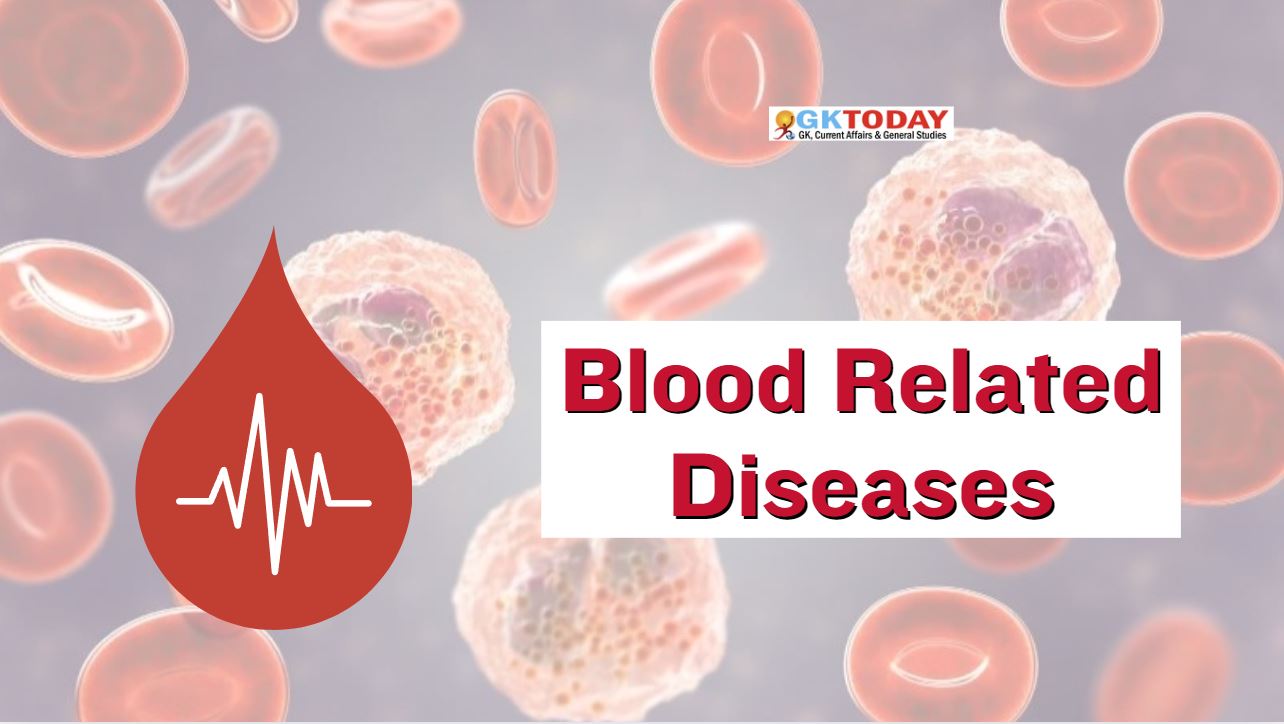Blood Related Diseases
Sickle-cell disease
Sickle-cell disease (SCD) is an autosomal recessive genetic blood disorder with overdominance, characterized by red blood cells that assume an abnormal, rigid, sickle shape. Sickling decreases the cells’ flexibility and results in a risk of various complications. The sickling occurs because of a mutation in the haemoglobin gene. Red Blood Cells alter shape and threaten to damage internal organs.
Anemia
Anemia refers to low RBC count or low hemoglobin or abnormality of the RBCs. It is characterized by low oxygen transport capacity of the blood.
Pernicious anemia is an autoimmune disease in which body lacks intrinsic factor required to absorb vitamin B12 from food. Vitamin B12 is needed for the production of hemoglobin.
Aplastic anemia is caused by the inability of the bone marrow to produce blood cells. Pure red cell aplasia is caused by the inability of the bone marrow to produce only red blood cells.
Thalassemia
Thalassemia results in the production of an abnormal ratio of hemoglobin subunits. It’s a genetic disease.
Malaria link of Sickle-cell disease and Thalassemia
Malaria parasite spends big part of its life-cycle in Red Blood Cells. During this period it feeds on the hosts hemoglobin and then breaks them apart. This causes fever at several intervals. Both sickle-cell disease and Thalassemia are more common in malaria prone areas, because these mutations convey some protection against the parasite.
Leukemia
A great increase in abnormal leukocytes may occur for unknown reasons, resulting in the diseases known as the leukemias. These range in severity from the chronic lymphocytic leukemia, in which a person may live for many years, to devastating acute leukemia, often causing death within months.
Thromboembolic Disease
This disease results in abnormal clotting in the blood vessels. It is caused by a relatively inactive lifestyle, or by a person’s confinement to bed, is one of the most common causes of death in middle-aged and elderly persons.
Arteriosclerosis
The single major cause of artery disease is the thickening and hardening of arterial walls by deposits of fatty materials, known as arteriosclerosis. In major vessels such as the aorta, this process is called arthrosclerosis. These are common cause of coronary heart disease, including heart attacks. Bypass surgery, the surgical replacement of the narrowed segment of artery with a vein taken from elsewhere in the body, is a common medical treatment for arterial narrowing in coronary arteries. Another medical therapy, angioplasty, is the dilation of the narrowed segment with a tiny balloon delivered by catheter.
Aneurysms
Other major diseases of the aorta include true aneurysms and so-called dissecting aneurysms. The former are balloon-like swellings that result from weakening of the aorta wall, most commonly because of atherosclerosis.
Vein Diseases
The most common peripheral vascular disease of the veins is thrombophlebitis or phlebitis. This disorder involves the formation of a blood clot (or clots) in large veins, usually in the leg or pelvis. A distressing but usually minor disorder of the veins, known as varicose veins, results from a failure of valves in the veins to keep blood flowing back toward the heart.
Hypertension
High blood pressure is a common disorder among the adult population. By far the most common type is essential hypertension, the causes of which are medically unknown. The remaining cases of high blood pressure are secondary to at least 30 different conditions.
Stroke
Stroke, also known as Cerebro-Vascular Accident (CVA), involves damage to the brain because of impaired blood supply and causes a sudden malfunction of the brain. Some stroke risk factors include increasing age, gender (more men have strokes), diabetes mellitus, prior stroke, and family history of stroke, hypertension, heart disease, cigarette smoking, and transient ischemic attacks (TIAs), or little strokes. Strokes are of three kinds viz. Ischemia, Haemorrhage and Heart Failure. Ischemia is the narrowing or blockage of an artery by means of atherosclerosis or by an embolus.
- About 63% of strokes are ischemic. Atherosclerosis, or progressive hardening of the arteries, produces ischemia by obstruction of vessels with fatty deposits. Another form of ischemia is thrombosis, or blockage resulting from an embolus.
- About 22% of all strokes are caused by cerebral hemorrhage or bleeding in the brain. The most common causes of spontaneous intracranial hemorrhage, commonly called apoplexy, are hypertension and aneurysm.
- Heart Failure is a condition in which the heart fails to maintain an adequate output, resulting in diminished blood flow and congestion in the circulation in the lungs and/or the body. The causes of heart failure are high blood pressure and heart disease. To properly manage heart failure the underlying heart disease must be treated.


